How two savvy cities leveraged ARPA funding for post-pandemic success.
Story by Devon O’Neil
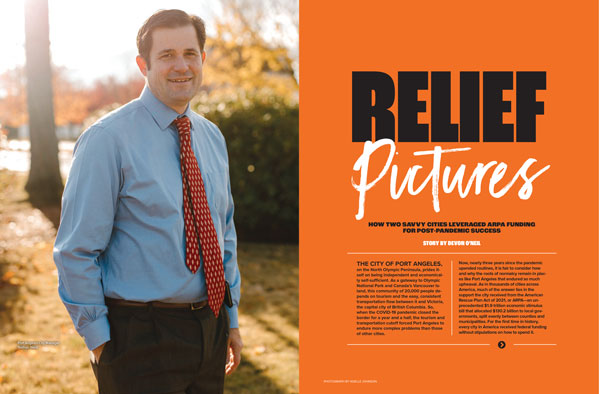
Port
Angeles City Manager Nathan West
The City of Port Angeles, on the North Olympic Peninsula, prides itself on being independent and economically self-sufficient. As a gateway to Olympic National Park and Canada’s Vancouver Island, this community of 20,000 people depends on tourism
and the easy, consistent transportation flow between it and Victoria, the capital city of British Columbia. So, when the COVID-19 pandemic closed the border for a year and a half, the tourism and transportation cutoff forced Port Angeles to endure
more complex problems than those of other cities.
Now, nearly three years since the pandemic upended routines, it is fair to consider how and why the roots of normalcy remain in places like Port Angeles that endured so much upheaval. As in thousands of cities across America, much of the answer lies in
the support the city received from the American Rescue Plan Act of 2021, or ARPA—an unprecedented $1.9 trillion economic stimulus bill that allocated $130.2 billion to local governments, split evenly between counties and municipalities. For
the first time in history, every city in America received federal funding without stipulations on how to spend it.
ARPA was designed to kickstart cities and towns across the country, smoothing the transition to—or just making possible—their post-pandemic lives. Of the $65 billion granted to U.S. municipalities in 2021 and 2022, 276 Washington cities are
projected to receive $1.1 billion, with the state’s 39 counties getting another $1.4 billion. Cities have spent the money on everything from childcare and mental healthcare to housing, transit, and small-business assistance. Kent built a park
in a park-deficient neighborhood. Fife started a job-training program for people experiencing houselessness. Walla Walla committed $3.2 million to improve its public outdoor areas. Kenmore pledged the same amount to a new affordable housing development—and
provided $1 million in direct cash assistance to residents living at or below 50 percent of the area’s median income. ARPA’s only restrictions are that costs must have been incurred after March 2021 and funds must be obligated by the end
of 2024—then spent by the end of 2026.
Port Angeles City Manager Nathan West says local leaders “really wanted to make sure we were focused externally” with their $5.6 million in ARPA funding. “We turned this federal relief back out to the community in support of their needs.”
That meant a lot of things, but of the first $2.8 million that Port Angeles allocated, almost 20 percent—$500,000—went to a for-profit local company that was vital to the community. Black Ball Ferry Line is one of the only privately operated
ferry services on the West Coast. In pre-COVID times, the company shuttled around 120,000 vehicles and 470,000 people between the U.S. and Canada annually. Its 340-foot flagship can fit 115 vehicles and 1,000 people on each trip, and had a daily schedule
that started at 6 am in Victoria and finished at 11 pm. Anyone who lives or does business in Port Angeles knows the 62-year-old operation is the lifeblood of the community and local economy. In fact, Black Ball’s annual economic impact on Port
Angeles is estimated to be $64 million.
The ferry had always operated with fiscal responsibility and was well-positioned to sustain itself during an economic downturn. However, no one foresaw that the ferry wouldn’t be able to operate at all for 20 months, losing an estimated $20 million
in revenue. Its public service value, one could argue, was no different from a bridge connecting communities that rely on each other. But since there aren’t many similar businesses, and thus no clear avenue for government funding to sustain
it, ARPA—and its more flexible rules around allocations—was critical. The city’s half-million-dollar grant—its largest to any single entity, including nonprofits and government agencies—augmented the $4.9 million that
Black Ball received from the state and the $1.2 million it obtained from Clallam County. “It was important to us to step up locally and help a business that has been so important to the community,” says West.
Ryan Burles, Black Ball’s president, says the grants allowed the ferry service to keep its 75 full-time staff employed, and to maintain their uninterrupted health insurance. Many of the company’s employees are the second or third generations
in their families to have worked on the ferry. “Not having to replace their knowledge and expertise helped us so much,” says Burles, who started working for Black Ball as a student in 1981. “We worked hard at making our argument
for funding,” he adds, “but it turned out that whether it was city, county, or state, they all had local knowledge of what our service was and our importance to the region. There seemed to be a real desire to help however they could.”
The same could be said of a lot of Washington’s municipalities, including a much smaller drive-through city where, like in Port Angeles, ARPA has helped the community move forward in ways that could make it more livable and prosperous for decades
to come.
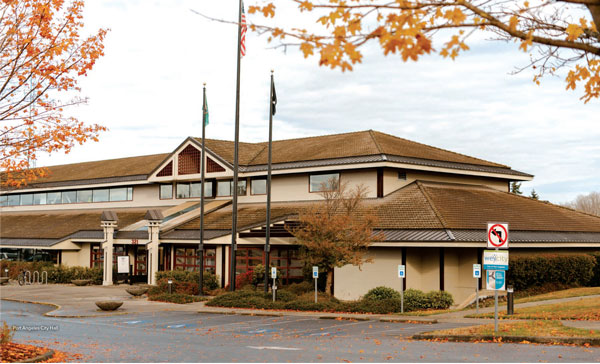
Port Angeles city hall
Some 180 miles east of Port Angeles, Sultan sits inland at the confluence of the Sultan and Skykomish rivers on U.S. Highway 2, one of two main east-west thoroughfares in the state. It’s a bucolic town in beautiful Snohomish County, and a frequent
quick-stop for recreationists zipping by on their weekend drive to Leavenworth. More than 28,000 cars pass through each weekend, and with eight restaurants, Sultan’s biggest economic driver before the pandemic was the service industry. That
changed during COVID-19, when the lure of small-town life drew people out of cities. “A lot of Seattleites sold their $800,000 homes and got a better house here for half the money,” says Will Ibershof, Sultan’s city administrator.
“We want to bring people downtown not just as a public good, but also to drive economic activity. That ecosystem of community and local businesses supporting each other is really key.”
– Russell Wiita, City of Sultan Mayor
The city’s population grew from 5,000 to 6,300 between 2020 and 2022—a leap of 26 percent. Nonetheless, events ceased, and programs nose-dived. Those who’d migrated to Sultan were hibernating, leaving leaders wondering how to jumpstart
their community-at-a-crossroads.
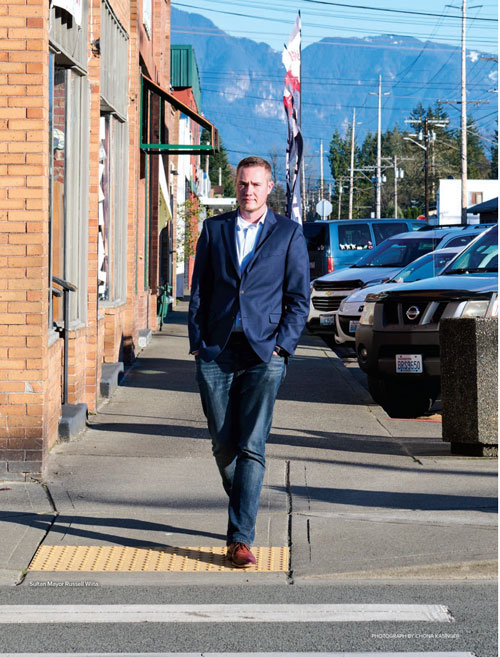
Sultan Mayor Russell Wiita
Early on, the city used $50,000 of its $240,000 allocation from the March 2020 Coronavirus Aid, Relief, and Economic Security Act (a.k.a. the CARES Act) to give 20 local businesses each a $2,500 grant, keeping them afloat when other towns were losing
local shops (to receive the grant, the business was required to show that it had experienced a revenue loss over the last year). But that didn’t solve all the city’s problems. Once ARPA money arrived in 2021, Sultan invested $200,000 to
hire an economic development director, Melody Daizey, at the Sky Valley Chamber of Commerce— with the intention of funding the position for at least three years. One of Daizey’s most urgent charges was to fill the empty storefronts where
shops had closed in Sultan’s commercial core—a precursor to the broader goal of revitalizing the downtown area. She had no problem finding tenants, including a potential new grocery store, but soon came up against a lack of available space.
With the overarching goal of revitalizing the downtown core becoming ever more important, Daizey and city leaders like Ibershof faced a host of intertwining considerations. For example, how could the city serve its newcomers and still maintain a healthy
growth trajectory? Or, how could the city encourage hikers heading home from popular attractions to stop and eat on their way through Sultan?
Luckily, Ibershof, now in his fourth year as administrator, was recruited in 2005 in part because of his previous work as three-term mayor of Duvall, a half hour southwest of Sultan. There, he brought energy and commerce back to downtown Duvall, despite
the Great Recession and the significant growth in the years that followed. “Duvall became more of a destination place once we had a revitalized downtown,” Ibershof says. “And Sultan has a much larger traffic count than we did in
Duvall.” Which means the potential for positive impacts on the economy is high if the city can figure out how to unlock it.
Soon after hiring Daizey, Sultan invited students from the University of Washington’s Evans School of Public Policy and Governance to consult on its vision for a fresh downtown. Students engaged the local business community, asking key questions
such as, ‘What do businesses need from the city? What are businesses willing to do?’ and ‘How do we make the partnership between entrepreneurs and local government work?’” Then the city engaged UW’s architecture
school to create a Storefront Studio Book (online at sfs.be.uw.edu/locations/sultan-2022), which sketched out the infrastructure that might be built to bring the visioning plan to life. The city spent $12,000 on its visioning outreach and
$3,500 on the studio book. “We saw it as great bang for our buck,” Ibershof says.
Mayor Russell Wiita describes it all as a confluence of timing, since residential growth is often followed by commercial growth. “We want to bring people downtown not just as a public good, but also to drive economic activity,” he says. “That
ecosystem of community and local businesses supporting each other is really key.”
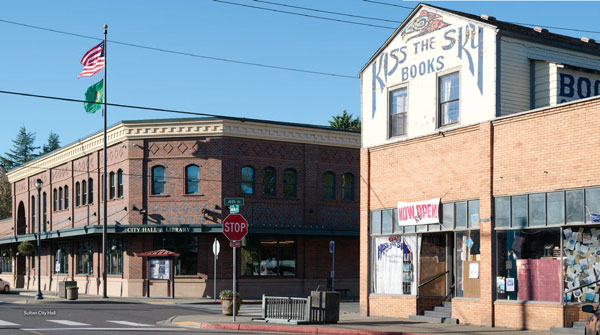
Sultan city hall
Which, of course, is where ARPA comes in. “These funds provide a one-time, historic opportunity,” Wiita says. “Our ideas aren’t necessarily new; they’ve been talked about a lot, but we just haven’t had the resources
to do it. So, the ARPA funds have given us an opportunity to do things that otherwise we just wouldn’t have been able to do.” For example, the city has looked at acquiring a piece of downtown property multiple times over the years, but
it’s difficult for private businesses to operate in because it floods almost annually. Now, the city is in conversations to buy it and turn it into a chameleon of sorts: During non-flooding seasons, Wiita says, it could be used for indoor market
or community events, then as a business incubator to let home-based shops see what a retail or service front would look like. “We’re talking with the chamber to set that up if we get the space,” Wiita says, who adds that the space
would be built to be “flood ready” so that fixtures and equipment could be easily removed when needed.
Sultan has only spent $400,000 of its $1.5 million allotment, and leaders are trying to figure out what to do with the rest (collectively Washington’s cities had spent or obligated approximately half of their $1.1 billion ARPA money as of April
2022). Regardless of specific expenditures, Sultan’s remaining money is likely going to enhance the downtown core even more. “I really want to make it an inviting place to come, day or night,” Ibershof says. “[So] you go to
your friends or family and say, ‘Hey, I hear Sultan’s got some new things going on, let’s go downtown and take a look.’”
Sultan epitomizes the trend being borne out as municipalities emerge from the pandemic. Younger leaders are shaping their cities’ futures more often, a particularly salient trend when those cities are at a crossroads. Consider the career path of
Wiita, Sultan’s 28-year-old mayor, who was born and raised in the city. As class president in high school, he served as a student representative on city council, a non-voting position the city created to encourage input from younger perspectives.
His senior year, Wiita earned an Association of Washington Cities Center for Quality Communities scholarship—a program that provides post-secondary scholarships for young leaders who get involved in community service or local government. Wiita
majored in political science at UW, served in the student senate, and spent a legislative session in Olympia interning for the Washington State House of Representatives. After graduating college in 2015 he returned to Sultan and moved in with his
dad, a union millwright who works on luggage conveyor belts at Seattle-Tacoma International Airport. When one of the council seats came open, the outgoing member called Wiita and encouraged him to run.
He was elected at age 21, earning 74 percent of the vote against a male opponent who was 54 years his senior. Four years later, he ran for mayor and won handily at age 25. In his day job, he works as a legislative aid for Snohomish County Councilmember
Nate Nehring, 27, who was appointed at age 21 (and who happens to be the son of Marysville Mayor John Nehring).
Ibershof noticed Wiita’s efficiency and new ideas right away. “The mayor who hired me was a 67-year-old retired guy who had a tiny dog, loved paper, and didn’t want to see anything on the screen.” Ibershof chuckled. “Now
I work for a 28-year-old guy with a giant dog who prefers that everything we do is electronic.”
Ibershof started carrying around a notebook to ensure he didn’t miss any of Wiita’s suggestions. He cites the “positive energy” that younger government workers have brought to the job. “It’s not, ‘Woe is me, this
isn’t going to work,’ it’s, ‘Hey, let’s find a way to make it work.’ They provide a fresh perspective, especially on how to reach people. I just assumed when I started in politics that if I post things on the city
website it’s enough. But that’s not the case.” Sultan is using social media more often to engage its new (and often younger) residents. The city has brought in a series of interns on a project basis to help with everything from post-pandemic
finances to communications. Many municipalities are now hiring management analysts—jacks of all trades who are often recent graduates of master’s programs or former city interns. “People are used to doing things a certain way,”
Ibershof says. “No disrespect to [veteran] city employees, but [new employees] come in and say, maybe there’s a better way.”
Back in Port Angeles, where the city at press time had allocated about $3.1 million of its $5.8 million ARPA funds, the focus with the remaining money remains to make the city a more livable place—one that is more resilient to calamities like a
pandemic. Nowhere is that more evident than its housing and social programs investments.
Port Angeles has long been recognized as a leader statewide on affordable housing (the city provided a one-pager summarizing its success to the governor’s office last year), but a 2019 study found it would need an additional 2,941 units by 2030—
and that was before COVID made teleworking the norm and spawned a real estate boom that exacerbated the problem. “We’ve seen a growth in those experiencing homelessness, but more generally, the wages in our community don’t
cover the costs of housing,” City Manager Nathan West says. “A migration of people moving here due to the pandemic has priced our residents out. Landlords have increased rents...and we’re also seeing an impact from short-term rentals
due to increases in tourism.”
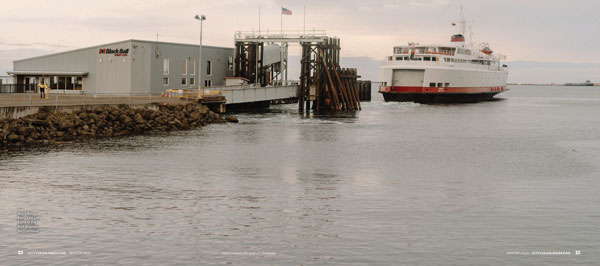
Black Bell Ferry Line’s MV Coho at the Port Angeles ferry
terminal
Port Angeles has already obligated more than $1 million from ARPA on housing internally and externally. The city hired a housing coordinator on a temporary two-year position (cost: $225,000, including benefits); gave Peninsula Behavioral Health $337,500
to help purchase an old motel on a prime arterial street and turn it into 27 new housing units; contributed $250,000 to the Peninsula Housing Authority to buy a multifamily property; and granted Habitat for Humanity $100,000 to help retain and rehabilitate
existing housing stock, allowing members of the community’s substantial elderly population to age in place. “For other cities, these numbers might seem small,” West says, “but for our jurisdiction, they’re a really big
deal.”
Childcare was also a focal point. The city’s most recent ARPA allocation last spring was $250,000 to the Olympic Peninsula YMCA to build a new childcare facility that will serve local families for years to come. That followed a $106,000 grant in
late 2021 to the Boys & Girls Clubs of the Olympic Peninsula’s morning camp and a $98,700 award to the Shore Pool Spark Club after-school program. For the Boys & Girl’s Club, Port Angeles covered two years of subsidies that allowed
the camp to continue charging the reduced rate offered during the pandemic. “It was a win-win because our families kept being able to enjoy that discount, and we no longer had to absorb the cost,” says Resource Development Director Janet
Gray. “It was vital to our sustainability. It also helped keep our staff employed.”
West rattles off a list of other social programs the city has supported, from food banks to utility relief to a $40,000 contribution to the Center for Inclusive Entrepreneurship, whose mission is to help people with limited resources in marginalized rural
communities start a business, earn a living, and thrive. “We want to do everything we can to make sure they survive and feel supported,” West says.
You could argue that same vision applies to the rest of Port Angeles’s actions, as well as those in Sultan. It is a vision shared by communities across Washington, and it’s no stretch to say it fulfills the mission of ARPA itself.